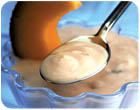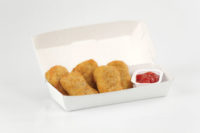Gumming for the Alternative

Gums exhibit a range of properties including thickening, gelling, emulsification and suspension. Each type of gum behaves differently under various circumstances. Some exhibit a synergistic reaction with other gums, while others have specific functions only under certain conditions, such as in the presence of particular ions. Most gums are hot water-soluble, while a select few are soluble in cold water. Furthermore, solubility may not only be affected by temperature, but by the presence of solutes such as salt or sugar. Ultimately, gel texture may be a critical parameter of a food formulator's finished product target, and thus adds another factor for consideration toward ingredient selection, as gum textures range from firm and brittle to soft and elastic. Thus, the reasons for arming oneself with adequate knowledge of hydrocolloid interactions become readily apparent as the complexities associated with this versatile category are revealed.

Are You Gellin'?
Properties of gums that influence viscosity vary from thickening to gel formation. Viscosity is enhanced by spheres of rotating, extended polysaccharides colliding in solution. Extended, linear molecules generate more viscosity in solution than folded or highly-branched molecules. For example, gum Arabic is a branched polymer and has a low viscosity, while locust bean gum (LBG), a substituted-linear polymer, is highly viscous at low concentrations.Gels are matrices formed by joining polymers together in solution to form a structure that exhibits solid-like behavior. This process occurs through chemical bonding or cross-linking. Entwined polymers form helices or align themselves in linear fashion. These cross-linked helices or stacks further align themselves to form a junction or “superjunction,” the size of which determines the clarity of the gel. Gel strength is affected by the type, stability and number of bonds produced.
Hydrocolloids that have negatively charged side groups (e.g., acetyl or carboxyl) become susceptible to pH conditions when like charges are present because like charges repel one another and prevent gelation from occurring. Gelation will take place when the negative charge is neutralized. On the other hand, oppositely charged polymers (e.g., an anionic hydrocolloid and a protein below its isoelectric point) will irreversibly bind to one another and precipitate out of solution. A combination of pectin and gelatin at certain pH levels will exhibit this type of a reaction, notes Pretima M. Titoria, PhD, ingredients section manager for Leatherhead Food International.
“High-methoxy (HM) pectins seem to require the most particular conditions for gelling including high temperature, a specific pH range and solids content,” explains Michael P. Wanous, PhD, MBA, senior consultant for Best Vantage® Inc. and adjunct professor of Nutrition Science at Dominican University, River Forest, Ill. “Though the degree of esterification of HM pectin can be selected for best performance according to the solids content (>55%) of the substrate, low-methoxy (LM) pectins offer more flexibility, requiring heat and Ca2+ for gelation.”
Most gelling hydrocolloids require heat for hydration, and some require the presence of monovalent or divalent cations, suggests Titoria. An example is the alginate gum, which is unique in that it forms a gel in a chemical reaction with calcium without heat. “Manipulation of calcium availability through the selection of the calcium source is usually critical,” she adds. The resulting gel is heat-stable and traditionally thermally irreversible.

A Little Give-and-take
Synergistic reactions between gums are not pervasive, but do occur under certain situations. Enhanced viscosity, lower use level and improvements in texture represent examples of the effect that these gum-to-gum synergies have on one another, notes Rodger Jonas, national business development manager of an ingredient supplier based in Morristown, N.J. Synergies also can result in increased gel strength.Galactomannans, or a type of polysaccharide produced from seeds possessing a mannose sugar backbone with galactose side chains, react synergistically with one another, notes Wanous. Galactomannans include guar gum and LBG, which have a mannose to galactose ratio of 2:1 and 4:1, respectively. Guar and LBG each react with xanthan gum. However, guar merely thickens xanthan, while LBG actually forms a gel. Wanous attributes the latter phenomenon to LBG's structure. In essence, the existence of fewer side chains favors the formation of a tighter gel structure.
Neither LBG nor xanthan gum will gel on its own, but will produce a thermally reversible (meltable) gel upon heating and cooling. It is the ratio of xanthan to LBG that determines the final gel texture, notes Titoria. For instance, an equal mixture of xanthan to LBG will generate a strong, elastic gel, while a greater ratio of LBG to xanthan produces a more spreadable gel.
Synergistic reactions not only occur between two different polysaccharides, but also between particular gums and other ingredient types. “Gelatin and carrageenan increase gel strength synergistically at pH 6.0 or higher, and gelatin and gellan gum show a similar increase in gel strength by synergistic means at pH 5.0 or above,” explains Titoria. In addition, “LBG and carboxymethyl cellulose can develop a synergistic viscosity increase with caseins.”
It is the synergistic reaction between carrageenan and casein that is perhaps the most widely recognized. A variety of dairy products from ice cream to chocolate milk contain k-carrageenan, which forms a weak gel in the presence of positively charged amino acids associated with the milk protein, casein. The reactivity of k-carrageenan with meat proteins provides added functionality in processed varieties in regards to texture, sliceability and moisture retention, notes Wanous.
Mitigating Circumstances
Issues inevitably arise during any type of development process. “The selection of the wrong gum can offset and minimize the impact of another gum's intended purpose. The type of salt can cause syneresis with specific types of carrageenans; hardness of water can reduce effectiveness of certain gums; and pH, improper mixing and temperature can all impact gel set,” says Jonas. Once again, knowledge of hydrocolloid interactions may be the key to combating problems such as these. Unwanted problems can be prevented by paying attention to information that may otherwise seem trivial, such as that dealing with proper ingredient addition to a food matrix. For instance, the formation of surface mottling often can be avoided by blending a fine-mesh gum with other dry ingredients prior to hydration.
One key factor in achieving efficient and effective functionality with any hydrocolloid is adequate and full hydration, notes Wanous. Any gelling hydrocolloid that requires heating for hydration must be heated to the proper temperature; otherwise, gelling will not occur upon cooling. Higher temperatures may be required when ions are present in solution, as these ions can impede hydration. Higher temperatures create the kinetic energy needed to disrupt the chemical associations formed by the presence of ions.
“Some hydrocolloids are not very acid tolerant,” says Wanous. “The functionality of most is reliant on the length of polymer chains, allowing for the formation of networks brought together most commonly via divalent cations. If the integrity of these long chains is negatively affected, gelling cannot occur as efficiently or effectively as necessary, resulting in the potential breakdown of gels over time. Carrageenans typically do not exhibit strong acid tolerance.”
Development of new thickeners and gelling agents continues as manufacturers search for lower cost and more effective solutions for food product developers. Titoria describes her company's efforts at finding new solutions: “The aim is to develop a range of mixed polysaccharide gelling systems by manipulation and control of molecular weight distributions of interacting polysaccharides. This will allow for development of a broader range of improved and new gel textures that can be tailor-matched to various food, drink and pharmaceutical applications.” All of us look forward to future developments as we attempt to keep pace with the complex world of hydrocolloids.
Looking for a reprint of this article?
From high-res PDFs to custom plaques, order your copy today!



